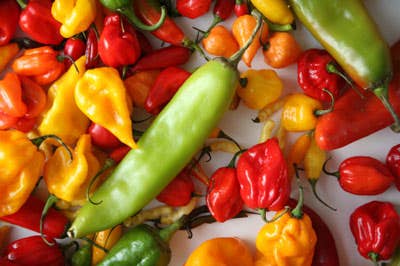
When I began growing peppers in my New Jersey backyard, seven years ago, I tried to restrain my mad-collector instinct at first, planting only the hot cultivars I knew would take well to the region's warm, humid summers: fiery habaneros, natives of Mexico's Yucatan peninsula; floral-tasting scotch bonnets, the habanero's cousins from the Caribbean; and reliable jalapeños and serranos, the workhorses of Mexican cooking. But soon, encouraged by a bumper crop, I became more adventurous. Within three years I had graduated to about a hundred cultivars, most of them central to the cooking of the Americas, the birthplace of peppers. Now, during the summer, peppers occupy every sunny patch of soil in my backyard—a vista of beautiful, thriving plants bearing fruits as bright and dazzling as Christmas tree lights.
The experience has been a fascinating chapter in my long quest to understand the astonishing botanical diversity of the Capsicum genus, to which all peppers belong, and to explore the myriad ways in which cooks in my native Latin America have come to use these ingredients. The visual guide that appears on the following pages features 48 peppers, some well known in the United States and some obscure—a cross section representing a vast range of size, color, heat, and flavor. I've been able to grow them as seedlings from domestic purveyors and use them all interchangeably in my cooking. In doing so I've gained an immense appreciation for the versatility of these fruits. They not only add heat to food but lend beguiling tastes and bring sweet, sour, and salty flavors into sharper focus, whether I'm using them in a slow-simmered Peruvian chicken stew, a tangy ceviche, or a fresh table salsa.
The study of chiles has given me a deeper understanding of Latin American cuisines, revealing, for example, how a preference for hot peppers among indigenous populations has profoundly shaped the cooking of Mexico, Guatemala, Peru, and Bolivia; how the Spanish inclination toward sweet varieties like the cubanelle and the aji dulce has helped define the cuisines of Cuba, Puerto Rico, and the Dominican Republic, where pre-Columbian cultures have largely disappeared; and how an African penchant for fiery pepper condiments traveled back across the Atlantic to influence the foods of the Caribbean and Brazil.
It is no accident that peppers are the backbone of New World cooking: they originated in South America, probably in a region encompassing parts of Brazil, Paraguay, Argentina, and Bolivia. The Capsicum genus, a branch of the Solanaceae family, contains 31 known species, only five of which are domesticated. Over the centuries, those five species traveled from their places of origin; they were manipulated by farmers so they'd produce a kaleidoscopic array of subvarieties. The majority of cultivated peppers today are of the species C. annuum, which evolved from a tiny, devilishly hot wild pepper and now comprises most of the commercial peppers available in the United States, including jalapeños. C. chinense peppers exhibit a wide range of heat levels and, often, tropical-fruit and herbal notes. C. baccatum encompasses the most important cooking peppers in the Andes, like the fruity aji amarillo. C. frutescens peppers are generally small and slender, ripening to a bright red; they've found a special niche in Central America and other parts of the world. Finally, there are the Andean C. pubescens peppers, lovers of high elevations and cool climes; the species exhibits only a few pod types, of which the chubby rocoto (a mainstay of Peruvian and Bolivian cooking) is the best known.
All capsicums are fruits (technically berries) with a usually lustrous skin and a ribbed and seed-filled interior. All contain phenolic compounds called capsaicinoids, which account for their heat and are concentrated in the fruit's soft, pithy placenta. That heat can range from a mild, lingering tingle to a clean, sharp bite to a ferocious burn—sometimes in cultivars that look remarkably alike on the outside.
On first encountering capsicums in the Greater Antilles, Spanish explorers dubbed them pimientos, no doubt because their piquancy reminded them of black pepper (pimienta). Eventually, they also took to calling them chiles, after the Nahuatl word for peppers, chilli, which they learned while conquering Mexico. Adding to the confusion, many Spanish settlers also adopted the indigenous Caribbean Taino word aji, which they disseminated throughout South America. When I speak or write of capsicums generally in English, I use just pepper; in Spanish, I'm more discerning, favoring the predominant term for peppers in whatever country I'm writing about: chile, aji, pimiento, and so on. For the peppers in the visual guide, I've used the most widely accepted commercial names.
Today, capsicums, which spread far and wide along expanding trade routes after the Spanish and Portuguese conquests, are deeply woven into the fabric of culinary life in many parts of the world, especially Southeast Asia and the Indian subcontinent. It is in their natal Latin America, though, that they find their most diverse expression.
Keep Reading
Continue to Next Story










